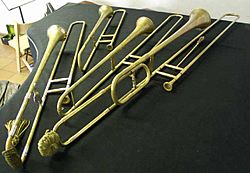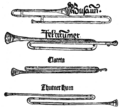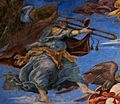Sackbut facts for kids

Sackbuts
|
|
| Classification | Brass |
|---|---|
| Related instruments | |
| Trombone | |
The sackbut is a brass musical instrument from the Renaissance. By the 1750s, it was developing into the modern trombone. The earliest instruments come from the 1500's.
The sackbut has narrower tubing, does not have a water key, a slide lock or a tuning slide that are found on trombones.
It is played by buzzing the lips into a mouthpiece.
The length of the instrument could be changed by the use of a sliding tube which meant it could play a full chromatic range of notes.
They were made in a range of sizes, a descant (rarely used), alto, tenor and bass. They were often played to accompany a church choir.
Images for kids
-
"Busaun" (trombone) and various trumpets by different names, from the 1511 treatise by Sebastian Virdung.
-
Sackbut in a fresco by Filippino Lippi in Rome, The Assumption of the Virgin, dating from 1488 to 1493. This is the earliest clear evidence of a double-slide instrument.
-
Trombones in Syntagma Musicum (1614-20), by Michael Praetorius.
-
Marin Mersenne, L'Harmonie universelle (1636).
-
Excerpt from a trombone part from a Picchi canzon (1625). The baritone clef seen here is very common for trombone parts of this era.
-
Trombone on a 1909 headstone, Christ Church, Todmorden
See also
 In Spanish: Sacabuche para niños
In Spanish: Sacabuche para niños









